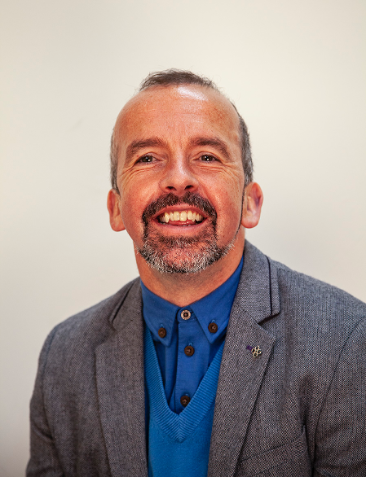2 December 2020
In September, we kicked off our first squad looking at digital transformation. The project is working in collaboration with three local authorities, Torfaen, Blaenau Gwent and Neath Port Talbot. The leads from each authority were keen to champion digital and new ways to improve services for their residents and all the project sponsors had a shared vision of the importance of service design to build better digital services that have been designed from a customer perspective.
This project is the first time the three councils have worked on a cross-cutting multidisciplinary project involving staff from different parts of the councils including social services and digital services and crossing organisation boundaries.
In this post, the three project sponsors tell us a bit about why they got involved, what it’s been like it, what they’re learning and what they’re hoping to achieve.
Anne-Louise Clark, Blaenau Gwent Borough Council

’Building public services fit for the 21st Century is an imperative for us all. Our residents expect to be able to access services and get their requests resolved quickly and easily. Now is the time to challenge our assumptions about how, where and when people want to interact with us. We need to think like our residents and the best way to do that is to talk to them, learn from them and involve them in shaping the future. Being involved in this project and working alongside CDPS gives us the opportunity to build better services, maximise the potential that digital solutions provide at the same time as seeking opportunities to remove waste, saving time and ultimately money. We are learning as we are going, developing solutions in real time, testing those solutions and changing them quickly when needed and discovering new opportunities. Working collaboratively with colleagues from NPT and Torfaen adds to the experience. Getting to know new colleagues, sharing experiences, jointly solving barriers and celebrating breakthroughs creates the conditions for creativity and innovation. It is like combining the best of all our superpowers. This needs to become the norm if we are to build better, stronger and more resilient services and to reset expectations. My hope is that this will act as a catalyst for a movement for good — putting our residents in the driving seat.’
Ian Vaughan, Neath Port Talbot Borough Council

‘Coronavirus has rapidly increased digital change globally and in turn raised residents' expectations of the services provided by councils and the opportunities that the internet era brings.
I was delighted when we were selected by CDPS to work on this pioneer project alongside Torfaen and Blaenau Gwent to build better digital services. Working in a truly agile environment for the first time has reinforced for me the benefits of working this way.
The discovery phase in particular has been one of the key elements that is often overlooked, especially where there can be pressure to come up with a predefined digital solution without fully understanding the needs and requirements of the users. The benefit of this discovery work and taking a user-centric and data-driven approach, is that it helps reduce the chance of building the wrong thing.
The constant communication and collaboration through sprint planning sessions, retros, weeknotes along with show and tells has helped us all learn quickly from each other.
I am looking forward to seeing how the research gathered during the discovery will help shape the prototype solution in the alpha phase, creating a better service for our residents.
What I have also been really excited about is how working with the CDPS on this project is providing insight and a better understanding of the vast opportunities in the delivery of service design. I thought the two recent service design workshops that were held for our Officers and Members were excellent and really hit the mark on the benefits this approach brings. The knowledge transfer of this way of working will be essential as we continue our digital transformation journey as a council and build on the work that we have already delivered as part of our Smart and Connected strategy.
We need to fully understand how best we continue to make this transition, the new digital roles and resources that are required to design and deliver user-centred services as part of our digital transformation.
I also hope this will help drive the shift toward common technical and service design patterns/standards that can be reused across the public sector in Wales. By working openly and collaborating with each other on digital projects can lead to further innovation that will not only benefit how we deliver our services but will also benefit our residents and businesses.’
James Griffin, Torfaen Borough Council

I’m delighted that we’ve taken a very important service that generates a high volume of transactions and are working closely with our customers and staff to see if we can find a better way of meeting their needs. This would also free up scarce staff time to do the most valuable work that they are uniquely qualified to do. If we can do this in one service, we may well be able to do something similar across a number of the council’s services, helping to create a much better customer experience and saving the council time and money.
We’ve discovered that nearly half of our transactions in adult social care relate to occupational therapy. Many of those are relatively simple to process with the right information, but 96% of these transactions are dealt with in a way that can be time-consuming for our staff and difficult to understand for our customers. I think we can find a much better way of helping customers to be better informed about what support is available to them from the council or other sources and, if they need the council, what is involved and roughly how long it would take.
Together with the experts at the Centre for Digital Public Services and in partnership with our colleagues from Blaenau Gwent and Neath Port Talbot councils, we have worked well and quickly with our customers, staff and other stakeholders to gain a good insight into the problems we need to solve and how to solve them. I’m confident that this work will make a big difference to not just occupational therapy and adult social care, but also to how the council manages high volume transactions as efficiently and effectively as possible going forward. I’m also confident that working closely and quickly with customers and staff to understand their challenges and prototype solutions is the best way of making some big positive changes for customers, staff and the council.